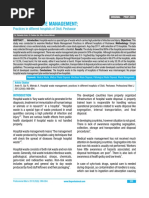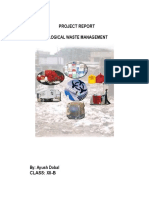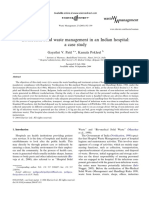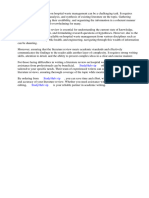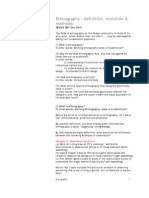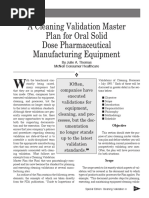Project
Project
Uploaded by
Pratik SarvankarCopyright:
Available Formats
Project
Project
Uploaded by
Pratik SarvankarOriginal Description:
Copyright
Available Formats
Share this document
Did you find this document useful?
Is this content inappropriate?
Copyright:
Available Formats
Project
Project
Uploaded by
Pratik SarvankarCopyright:
Available Formats
hospitals’ today
Biomedical waste management in a Large teaching hospital
Pandit NA, Tabish SA, Qadri GJ, Ajaz Mustafa
Abstract :
The scientific "Hospital Waste Management" is of vital importance as its improper management poses risks to
health care workers, waste handlers, patients, community in general and largely the environment.
Keeping this in view, bio-medical waste management was studied at "Sher-I-Kashmir Institute of
Medical Sciences, Srinagar" for a period of three months. Quantity of solid waste generated per bed per day
was found to be 2.02 Kgs. Inpatient area generated maximum solid waste (71.6%) followed by supportive
services (15.41%). Other areas like Operation Theater, Emergency and OPD together produced lesser
amounts (12.9%). In the waste management process, segregation and storage are not properly followed in
SKIMS. However, collection and transportation activities to final disposal are being practiced. The policy of
quality control system in waste management needs to be improvised.
JK-Practitioner 2007;14(1):57-59
The biomedical waste management and handling rules of 1998 of
Government of India requires every occupier of an institution generating
bio-medical waste, which includes a hospital, nursing home, clinic,
dispensary, veterinary institution, animal house, pathological laboratory,
blood bank by whatever name called to take all steps to ensure that such
waste is handled without any adverse effect to human health and
environment.
The bio-medical waste, by its definition includes solids or fluids,
their containers and any intermediate products generated during diagnosis,
treatment or immunization, in research pertaining there to or in the
1
production of testing of biological and animal waste. Hospital waste
generated from different units of hospital can cause serious health hazards
like spread of HIV infection, Hepatitis B and C etc. According to WHO,
around 85% of the hospital waste is non-hazardous, 10% infective and
2
Authors affiliations: remaining 5% non-infective but hazardous.
NA Pandit Management of Hospital waste is a major challenge to the
SKIMS, Medical College, hospitals. This waste has become a risk factor to the health of the patients,
Hospital Bemina hospital staff extending beyond the boundaries of the medical
SA Tabish, Prof. GJ Qadri, Ajaz establishments to the general population and to the environment, hence the
management of hospital waste at this tertiary care Institute was studied.
Mustafa
A study has been conducted at a 600 bedded teaching hospital
Department of Hospital (Sher-i-Kashmir Institute of Medical Sciences, Srinagar) to determine the
Administration SKIMS, Soura, quantity of waste generated and the methods of disposal.
Srinagar Methodology
Bio-medical waste management was studied at Sher-I-Kashmir
Accepted for publication : Institute of Medical Sciences (SKIMS) for a period of three months. A
December 2006 survey of the various hospital areas was done to study the process of
collection, segregation, storage, transportation, treatment and disposal of
Correspondence hospital waste. Through personal observations, the area-wise generation of
Dr. Nazir A. Pandit waste from inpatients, Accident & Emergency, Operation Theatre, OPD,
Depty Medical Superintendent, Laboratories, Kitchen, CSSD and Pharmacy was recorded. The actual type
and amount of waste was physically inspected to record different types of
SKIMS Medical College/
waste and their collection in different containers. These wastes were
Hospital subjected to weighing along with containers by a top pan balance (Krups-
Bemina, Srinagar 190 001 Duchess" model capacity 100 Kgs). Weight of the container was adjusted
for finding the net weight of the waste products, which was recorded. The
emphasis was laid on separate collection of bio-medical waste. Separate
containers were used for collection of such waste. Information derived from
questionnaires was verified by personal observations. The data was used to
calculate amount of waste generated in kilogram per bed per day by the
Keywords : Biomedical waste, Hospital , Waste management
JK- Practitioner Vol.14, No. 1, January-March 2007 57
hospitals’ today
following formulae. containers, which also gets mixed with bio-medical waste.
(a) Total waste produced during No segregation of waste is practiced. Different colour coded
period of study bags are not used at SKIMS for different types of wastes. No
= Mean waste generated labeling or marking, viz. hazardous/infectious waste is
No. of days of study per day being practiced. The general waste is collected in common
container in the wards which also contains part of bio-
medical waste. Most of the time the bio-medical waste is
(b) Mean waste generated per day
= Waste generated per bed also collected in separate containers. It is documented that
No. of beds per day such a practice of non-segregation may increase the costs of
final disposal of waste because the infective and non-
infective wastes get mixed up and hence the wastes that
Results could be disposed off by land-fill need incineration also
The different types of wastes generated at SIKIMS thus reducing risks and cost of waste management. Studies
include paper, soiled dressings, sponges, body tissue, waste in USA revealed that of all the workers who come in contact
ampoules, disposable masks, sharps, disposable syringes, with medical waste, those in the sanitary service report
drapes, catheters, drainage sets, colostomy bags, surgical highest on the job injuries; the annual rate varied from 10-
gloves and sweepings from hospital. Contaminated 20 per 1000 workers in other categories to 180-200 per
1
glassware, plastics, specimen container, specimen slides, 1000 workers in sanitation department (refuse collectors) .
and organs. Cartons, crates, packing material, metal In developed countries due to increased use of
containers, food container, solution bottles, pharmaceutical disposables the waste produced has been up to 5.24 Kgs,.3
bottles, waste from public and patients' rooms, waste food In hospitals of United Kingdoms, France, Norway, Spain,
material, waste from x-ray department. In SKIMS these Netherlands, USA and Latin America, waste produce is 3.3
wastes are not segregated in different types. Kgs, 2.5 Kgs, 3.9 Kgs, 4.4 Kgs, 4.2 Kgs, 4.5 Kgs and 3.8
4,5
Collection of waste is done in polythene bags and Kgs per bed per day respectively
PVC containers by skilled sanitary workers. The collected Most hospitals in India generate 1-2 Kgs per bed
waste from wards is transported through chute to the per day, except the tertiary care hospital (e.g. AIIMS and
propositioned tuggers lying under the chute. Tuggers are SKIMS) which produce waste on higher side.1 Wastes
also placed at some points in the hospital premises by generated in developing countries like India contain much
sanitation department for collection of waste. The waste less disposables and plastics than those generated in
from emergency, OPD, theatres and other service areas of developed countries due to difference in life style and use of
the hospital is collected in PVC containers, and then carried more disposable items. Increasing use of disposable in
to tuggers, which are being emptied at incineration plant tertiary care hospitals (AIIMS, SKIMS) may be the reason
where it is incinerated. The waste collected through chute of higher quantum of wastes generated.
into the tuggers is carried to municipal site for land filling as In patient areas contribute to 71.6% of the waste
most of it is domestic waste. Part of the waste (infectious generated at SKIMS followed by supportive serous 15.4%,
waste) from microbiology department is autoclaved. OPD emergency and theaters contribute to the extent of
Biomedical waste collected separately was found 12.9%. A study at AIIMS revealed that 67.5% waste
to be 17.22% of total waste generated. Amount of waste originated from in-patients, 13.4% from OPD and 15.4%
6
generated was 2.0 Kg per bed per day. 17463 Kg (71.6%) of from service areas
the total quantum was generated from inpatient area, 776 Untreated waste at SKIMS is transported from
Kg (3.2%) from OPD, 714 Kg (2.9%) from operation wards through Garbage chute which consists of a network
theater, 1644 Kg (6.75%) from emergency, 907 Kg (3.7%) of pipelines from various floors into tuggers which are
from laboratories, 724 Kg (2.9%) from pharmacy, 110 Kg prepositioned. Waste obtained from OPD and Emergency
(0.4%) from CSSD. Total waste from supportive services etc is transported manually to common collections points
was found to be 3760 Kg (15.4%). where collections is made directly into tuggers. One of the
Discussion disadvantages of Garbage chute is that it is difficult to keep
Managing waste has two vital parts: firstly it clean.
management of hazardous waste of different types There are not many national level studies on the
generated from different sources, which involves careful quantum of waste generated per bed per day. However, the
segregation collection, transportation and final disposal and average quantity of hospital waste produced in India has
secondly effective training and supervision of various been shown by various authors to the extent of 1.5 to 2.2
categories of personnel involved in whole waste Kg per bed per day 1 SKIMS and other tertiary care
management system. teaching hospital generates 2.02 Kgs per bed per day. The
For streamlining the process wastes have been results are almost concordrant with limited number of
classified and are to be stored in different colour coded studies from hospitals in other cities of India. Studies
containers or bags so that staff is able to recognize the conducted at AIIMS, New Delhi revealed that the quantum
appropriate container for each particular type of waste. of waste generated is 2.2 Kgs per bed per day,6 In Jaipur
7
Segregation is an important pre-requisite in the entire teritiary care hospital produces 1.5 Kg per bed per day. In
process of waste management as it allows special attention Mumbai Tata Memorial Hospital produces 1.13 Kgs per bed
to the relatively small quantities of infectious and hazardous per day. In Amristsar large tertiary hospital produces 1.05 to
waste, only domestic waste is being collected in separate 1.3 Kg per bed per day.
8
58 JK- Practitioner Vol.14, No. 1, January-March 2007
hospitals’ today
Government and private hospitals in Delhi Conclusion
produces 1.4-1.0 Kgs. per bed per day. 9 The quantity of SKIMS generate 2.02 Kgs per bed per day.
bio-medical waste generated at SKIMS was 17.2% while Though waste management practice in this hospital is better
as in Sanjay Gandhi postgraduate Institute of Medical than other hospitals in the state, yet, all the waste
10
Sciences, Lucknow generates it to the extent of 10-15%. management activities like collection, segregation,
For the wastes intended for off-site disposal, transportation, treatment and disposal need to be done on
generators must segregate sharps and fluids from other scientific basis. Segregation should start at the source of
wastes. Packaging material must be rigid, leak resistant, generation, containers of recommended colours should be
impervious to moisture and strong enough to resist tearing used for different types of wastes. Proper labeling and
and bursting. Containers holding untreated medical waste marking of infectious waste should be done. Since this is the
must be labelled as "infectious waste or medical waste" or first study of its kind in Jammu and Kashmir State, more
with the universal "bio-hazard" symbol. Packing must be research will be needed to devise the improvised policy of
marked to identify the generator, the transporter and the waste management practices and its quality control system
date of shipment . 11
in hospitals of the state.
References
1. Anand RC, Sidarth Satpathy. Management of Waste from 9. Baghatia KS. Study of Waste
Hospital waste management A Hospitals and Health Care Management Practices in Tertiary
holistic approach. Collection Establishments. Euro Report and Care Hospital. Thesis work
Definition Storage and Transport of Studies Annexure-III. Geneva 1985; submitted for M.D Community
Waste 2000; a 10, 14, 25, 26, 35, 58, WHO, 97. Health Administration at NIHFW,
120, 121. 6. Sarma RK, Mathur SK. Management 1998.
2. Management of Waste from of Hospital Waste. Journal of 10. Hem Chandra, Sunil Shishoo. Sharps
Hospitals and other Health Care Academy of Hospital Administration (Biomedical Waste) Management A
Establishments. Euro Report and 1989; 1(2): 55-7. model for implementation (An
Studies 1985; 1(97): 1-61. 7. Pathak S. Management of Hospital experimental study). Journal of
3. Singh IB, Sarma RK. Hospital Waste Waste : A Jaipur Scenario Proceeding Academy of Hospital
Disposal System and Technology. o f N a t i o n a l Wo r k s h o p o n Administration. June 2001; 13(1):
Journal of Academy of Hospital Management and Hospital Waste, 15-19.
Administration 1997; 8(2): 33-39. April 1998, 31-33. 11. James Studnicki. Hospital Topics.
4. Wa s t e C h a r a c t e r i z a t i o n a n d 8. Singh R, Mahajan SL. Management The Management of Hospital
Quantification "Parvesh" Newsletter of Hospital Waste in Hospital of Medical Waste Spring 1992; 70(2):
on Hospital Waste. CPCB, Ministry Govt. Medical College Amritsar. 11-16.
of Environment and Forests, Govt. of Journal of Academy of Hospital
India, New Delhi 1998; 4(IV): 3-4. Administration. Jan 1998; 10(1): 33-
5. Wo r l d H e a l t h O r g a n i z a t i o n 37.
JK- Practitioner Vol.14, No. 1, January-March 2007 59
You might also like
- 2.PsychoCrash Social Psy-1Document62 pages2.PsychoCrash Social Psy-1Gopika Sureshnv0% (1)
- Requirement Gathering Techniques - Final VersionDocument16 pagesRequirement Gathering Techniques - Final VersionPoornima HariNo ratings yet
- Linguistics, History Of: EF Konrad Koerner, Zentrum Für Allgemeine Sprachwissenschaft (ZAS), Berlin, GermanyDocument5 pagesLinguistics, History Of: EF Konrad Koerner, Zentrum Für Allgemeine Sprachwissenschaft (ZAS), Berlin, GermanyRanjan Kumar SinghNo ratings yet
- Evaluation of Bio-Medical Waste Management Practices in A Government Medical College and HospitalDocument5 pagesEvaluation of Bio-Medical Waste Management Practices in A Government Medical College and Hospitalbhaskardev84No ratings yet
- Hosp Waste ManDocument7 pagesHosp Waste ManVikas VikiNo ratings yet
- Journal Pone 0266888Document14 pagesJournal Pone 0266888oluwatobiloba stevensNo ratings yet
- BMW Manual 2018 - FinalDocument56 pagesBMW Manual 2018 - FinalRaja GcNo ratings yet
- Health Care Waste Management Practice in A HospitalDocument5 pagesHealth Care Waste Management Practice in A HospitalRekha SinghNo ratings yet
- Hospital ETP STP Paper PDFDocument7 pagesHospital ETP STP Paper PDFamitkenNo ratings yet
- Abdel Salam2010Document12 pagesAbdel Salam2010jesusNo ratings yet
- SEM ProjectDocument73 pagesSEM ProjectRahulKrishnan100% (1)
- Hospital Wastes Management at Different Government and Private Hospitals of Quetta City in Balochistan, PakistanDocument6 pagesHospital Wastes Management at Different Government and Private Hospitals of Quetta City in Balochistan, PakistanOpenaccess Research paperNo ratings yet
- Hospital Waste Management ArticleDocument5 pagesHospital Waste Management ArticleFarrukh AzizNo ratings yet
- Dr. Palanisamy Pasupathi-Biomedical Waste Management For Health Care Industry - A ReviewDocument15 pagesDr. Palanisamy Pasupathi-Biomedical Waste Management For Health Care Industry - A Reviewbhaskardev84No ratings yet
- 200-Article Text-801-2-10-20200606Document7 pages200-Article Text-801-2-10-20200606Gomathi KNo ratings yet
- Public Health and Preventive Medicine Current Hospital Waste Management Practices in Pakistan: Case Study and Curative MeasuresDocument6 pagesPublic Health and Preventive Medicine Current Hospital Waste Management Practices in Pakistan: Case Study and Curative MeasuresKashif HamdaniNo ratings yet
- Bio-Medical Waste Managment in A Tertiary Care Hospital: An OverviewDocument3 pagesBio-Medical Waste Managment in A Tertiary Care Hospital: An OverviewTheJokerNo ratings yet
- Research On Bio-Medical Waste For Academic Reference: ProjectDocument23 pagesResearch On Bio-Medical Waste For Academic Reference: ProjectBrandon SmithNo ratings yet
- Nutrition Dietetics - 2023 - Lewandowski - Packaged Hospital Food Appears Safe and Feasible To ReuseDocument10 pagesNutrition Dietetics - 2023 - Lewandowski - Packaged Hospital Food Appears Safe and Feasible To Reusekerwintong0116No ratings yet
- KALAISELVI Et Al, 2016Document8 pagesKALAISELVI Et Al, 2016MARIA FERNANDA OLIVEIRA SOARESNo ratings yet
- Hospital Waste ManagementDocument5 pagesHospital Waste ManagementUnzila AtiqNo ratings yet
- 2808 10467 2 PBDocument7 pages2808 10467 2 PBDidi NurhadiNo ratings yet
- Review of Literature of Biomedical Waste ManagementDocument8 pagesReview of Literature of Biomedical Waste ManagementafdtfhtutNo ratings yet
- N Engg - Ijget - Biomedical - D. Shreedevi - Dual - IjgmpDocument11 pagesN Engg - Ijget - Biomedical - D. Shreedevi - Dual - Ijgmpiaset123No ratings yet
- Metagenomic Analysis of Medical Wastes From Secondary and Tertiary Hospitals in Benin City, NigeriaDocument4 pagesMetagenomic Analysis of Medical Wastes From Secondary and Tertiary Hospitals in Benin City, NigeriaBIOMEDSCIDIRECT PUBLICATIONSNo ratings yet
- Dr. Palanisamy Pasupathi-Biomedical Waste Management For Health Care Industry - A ReviewDocument16 pagesDr. Palanisamy Pasupathi-Biomedical Waste Management For Health Care Industry - A ReviewSakinah 90No ratings yet
- Bio-Medical WAste Mange MentDocument24 pagesBio-Medical WAste Mange MentAnirudha Adithya100% (3)
- Literature Review On Health Care Waste ManagementDocument8 pagesLiterature Review On Health Care Waste ManagementaflrrefsnNo ratings yet
- 81-Article Text-523-2-10-20210318Document6 pages81-Article Text-523-2-10-20210318Risnawa Puji AstutiNo ratings yet
- Thesis Medical Waste ManagementDocument7 pagesThesis Medical Waste Managementlizsimswashington100% (1)
- Antisepsis/Disinfection/Sterilization: S4 Oral Abstracts / American Journal of Infection Control 47 (2019) S2 S14Document1 pageAntisepsis/Disinfection/Sterilization: S4 Oral Abstracts / American Journal of Infection Control 47 (2019) S2 S14Khansa LuthfiyyahNo ratings yet
- Project ChemistryDocument18 pagesProject ChemistryA MNo ratings yet
- Hospital Waste Management: - DR - Sharad H.Gajuryal, JR, MD Hospital Administration BpkihsDocument38 pagesHospital Waste Management: - DR - Sharad H.Gajuryal, JR, MD Hospital Administration Bpkihstushar panditNo ratings yet
- Contribution To The Establishment of A Sustainable Management System For Biomedical Waste in BeninDocument9 pagesContribution To The Establishment of A Sustainable Management System For Biomedical Waste in BeninIJAR JOURNALNo ratings yet
- Copy (2) of ThesisDocument20 pagesCopy (2) of Thesiscaridadlintao100% (1)
- JCM 02459-20Document11 pagesJCM 02459-20mara.v.alvarezNo ratings yet
- Cjidmm2020 5957284Document6 pagesCjidmm2020 5957284Bladimir CentenoNo ratings yet
- Lesson Plan of Demonstration On Biomedical Waste ManagementDocument16 pagesLesson Plan of Demonstration On Biomedical Waste ManagementSeema TanvirNo ratings yet
- Waste Management in Small Hospitals: Trouble For EnvironmentDocument5 pagesWaste Management in Small Hospitals: Trouble For EnvironmentYuan Lucky RNo ratings yet
- The Study of Solid Waste Management System of Hazardous and Poisonous Material in Public Health Centers of Barito Kuala Regency, South KalimantanDocument6 pagesThe Study of Solid Waste Management System of Hazardous and Poisonous Material in Public Health Centers of Barito Kuala Regency, South KalimantanOpenaccess Research paperNo ratings yet
- Hospital Waste Management: - DR - Sharad H.Gajuryal, JR, MD Hospital Administration BpkihsDocument38 pagesHospital Waste Management: - DR - Sharad H.Gajuryal, JR, MD Hospital Administration BpkihsJonathan delos ReyesNo ratings yet
- Journal LingkunganDocument6 pagesJournal LingkunganDelwim LibranitoNo ratings yet
- Biomedical Waste Management PDFDocument8 pagesBiomedical Waste Management PDFSujatha J JayabalNo ratings yet
- Literature Review Hospital Waste ManagementDocument7 pagesLiterature Review Hospital Waste Managementea2167ra100% (1)
- JCM 00910-19Document7 pagesJCM 00910-19Cris FischerNo ratings yet
- Inservice Education Bio Medical Waste ManagementDocument56 pagesInservice Education Bio Medical Waste ManagementPraveen John Edward William100% (1)
- Hospital Waste Management: - DR - Sharad H.Gajuryal, JR, MD Hospital Administration BpkihsDocument38 pagesHospital Waste Management: - DR - Sharad H.Gajuryal, JR, MD Hospital Administration BpkihsDhananjay ShimpiNo ratings yet
- Biomedical Waste ManagementDocument37 pagesBiomedical Waste ManagementDr.Rajesh KamathNo ratings yet
- Medical Waste - Background - Environmental Guidelines - Guidelines Library - Infection Control - CDCDocument6 pagesMedical Waste - Background - Environmental Guidelines - Guidelines Library - Infection Control - CDChosp.phaNo ratings yet
- Antibiotic Resistant Bacteria From Treated and Untreated Hospital Wastewater at Ayder Referral Hospital, Mekelle, North EthiopiaDocument16 pagesAntibiotic Resistant Bacteria From Treated and Untreated Hospital Wastewater at Ayder Referral Hospital, Mekelle, North EthiopiaAlina BanciuNo ratings yet
- 1 s2.0 S025508572100325X MainDocument3 pages1 s2.0 S025508572100325X MainAhmad ZakiNo ratings yet
- ArticleText 27718 1 10 202103253Document7 pagesArticleText 27718 1 10 202103253ujjaleshwarjmiNo ratings yet
- 30802Document16 pages30802YAMINIPRIYANNo ratings yet
- Weste ManagementDocument8 pagesWeste ManagementRhona Syakoer Marhabun Nawa0% (1)
- Reducing Waste in ICUDocument10 pagesReducing Waste in ICUzorbini69No ratings yet
- 1 s2.0 S0196655314006610 MainDocument4 pages1 s2.0 S0196655314006610 MainAhmad ZakiNo ratings yet
- PROJECTDocument20 pagesPROJECTdpk89214No ratings yet
- Cytotoxic Drug Dispersal, Cytotoxic Safety, and Cytotoxic WasteDocument8 pagesCytotoxic Drug Dispersal, Cytotoxic Safety, and Cytotoxic WasteBisamed.IDNo ratings yet
- Microbial Contamination of Nonsterile Pharmaceuticals in Public Hospital SettingsDocument8 pagesMicrobial Contamination of Nonsterile Pharmaceuticals in Public Hospital SettingsOghenekome Ereromebe AkpogumeNo ratings yet
- International Journal of Pharma and Bio Sciences Issn 0975-6299Document6 pagesInternational Journal of Pharma and Bio Sciences Issn 0975-6299Gusti YoandaNo ratings yet
- Practical Manual for Detection of Parasites in Feces, Blood and Urine SamplesFrom EverandPractical Manual for Detection of Parasites in Feces, Blood and Urine SamplesNo ratings yet
- Plant Disease Management Strategies for Sustainable Agriculture through Traditional and Modern ApproachesFrom EverandPlant Disease Management Strategies for Sustainable Agriculture through Traditional and Modern ApproachesImran Ul HaqNo ratings yet
- Lawson Compliance Waiver - Clinical ResearchDocument2 pagesLawson Compliance Waiver - Clinical ResearchShaheer ZahidNo ratings yet
- Ethnography QuestionsDocument8 pagesEthnography Questionsrohimah_rejabNo ratings yet
- Unit 10 Market Research in BusinessDocument10 pagesUnit 10 Market Research in BusinessChellie WalkingtonNo ratings yet
- Jeanne Kenney DepositionDocument225 pagesJeanne Kenney DepositionMarkingsonCaseNo ratings yet
- Reader-Friendly Writing - 1 3 25Document2 pagesReader-Friendly Writing - 1 3 25Lex McGuireNo ratings yet
- Patient Satisfaction With Clinical Pharmacy Services and The Affecting Factors: A Literature ReviewDocument10 pagesPatient Satisfaction With Clinical Pharmacy Services and The Affecting Factors: A Literature ReviewAychluhm TatekNo ratings yet
- Cleaning Validation Master Plan PDFDocument9 pagesCleaning Validation Master Plan PDFBREWSKI100% (1)
- Multicultural Diversity: Impact On Employee Interaction and Turnover StatusDocument8 pagesMulticultural Diversity: Impact On Employee Interaction and Turnover StatusYohanes Danang PramonoNo ratings yet
- Magentic OneDocument31 pagesMagentic OnemystrieNo ratings yet
- Tan Ong 2002 The Impact of Medical Technology On Healthcare TodayDocument6 pagesTan Ong 2002 The Impact of Medical Technology On Healthcare TodayAstri HandayaniNo ratings yet
- BooiSKAn Assessment of The Recruitment and Selection Strategies Used in The Sales Department of Old Mutual Group Schemes in The Eastern CapeDocument111 pagesBooiSKAn Assessment of The Recruitment and Selection Strategies Used in The Sales Department of Old Mutual Group Schemes in The Eastern CapeArefin SauNo ratings yet
- Dissertation Sur Le DesertDocument5 pagesDissertation Sur Le DesertHelpWithFilingDivorcePapersSingapore100% (2)
- Systematic Review of Research Trends in Robotics Education For Young ChildrenDocument24 pagesSystematic Review of Research Trends in Robotics Education For Young Childrensirgeorge1987No ratings yet
- The Impact of Personal Selling On The Purchasing Behavior Towards-With-Cover-Page-V2Document9 pagesThe Impact of Personal Selling On The Purchasing Behavior Towards-With-Cover-Page-V2kareena pooniaNo ratings yet
- Research ProposalDocument17 pagesResearch ProposalEllii YouTube channel100% (1)
- Assignment of Consumer BehaviorDocument12 pagesAssignment of Consumer BehaviorMinalNo ratings yet
- ShercingDocument98 pagesShercingKem InuNo ratings yet
- Research Org1Document5 pagesResearch Org1Jhon Benedict RomaNo ratings yet
- People Analytics: Transforming HR Strategy With Data ScienceDocument17 pagesPeople Analytics: Transforming HR Strategy With Data ScienceAlex EdwardNo ratings yet
- Problems - Decision Analysis v2Document6 pagesProblems - Decision Analysis v2ΩmegaNo ratings yet
- Mathematics and Statistics Undergraduate HandbookDocument12 pagesMathematics and Statistics Undergraduate HandbookMithun1992No ratings yet
- Hollis Tulasi Final PipDocument6 pagesHollis Tulasi Final Pipapi-427187217No ratings yet
- The Intersection of Gender and Race in The Labor MarketDocument28 pagesThe Intersection of Gender and Race in The Labor MarketCaro SánchezNo ratings yet
- Chapter30 Economic Impact of DiabetesDocument12 pagesChapter30 Economic Impact of DiabetessimainsusNo ratings yet
- CHN Lecture Summary 3Document6 pagesCHN Lecture Summary 3Fernand MataNo ratings yet
- Assignment WEEK 3Document8 pagesAssignment WEEK 3Soumyashis BhattacharyaNo ratings yet




